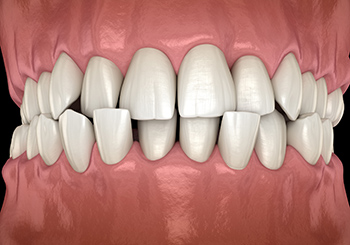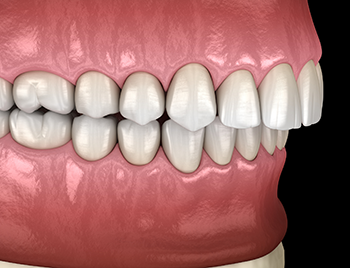
Teeth straightening is a dental procedure designed to correct the alignment of teeth. This is often achieved through orthodontic treatments such as braces or clear aligners like Invisalign. Misaligned teeth, also known as malocclusion, can occur due to various reasons, including genetics, thumb sucking during childhood, or jaw size discrepancies. Malocclusion refers to the incorrect alignment of the teeth when the jaws are closed. It can manifest in various forms, such as overcrowding, spacing issues, and bite problems. Proper tooth alignment not only enhances the aesthetic appeal of your smile but also contributes to better oral health.

In Class I malocclusion, the back teeth are aligned properly, but the front teeth overlap slightly. This is the most common type of malocclusion and is usually less severe.
Class II malocclusion occurs when the upper teeth excessively overlap the lower teeth. This type is often referred to as an overbite and can lead to significant dental issues if not treated.
In Class III malocclusion, the lower teeth overlap the upper teeth. This condition, known as an underbite, can affect the function and appearance of the teeth and jaw.
Dr. Jeremy Kurtz and the team at Invisalign Toronto have the experience and expertise to treat your malocclusion with Invisalign clear aligners. Dr. Kurtz has completed more than 4,000 Invisalign treatments and has been granted the status of VIP Diamond and Top 1% Provider.
Orthodontic appliances straighten teeth by placing gentle, controlled pressure on the teeth to guide them into the ideal position over time. These constant forces gradually move the teeth and cause the jaw to adapt to the new alignment. The process involves regular adjustments to ensure the teeth continue to move in the desired direction. Invisalign aligners, for example, are custom-made and replaced every few weeks to progressively shift the teeth. This method not only improves the appearance of your smile but also ensures the function and health of your teeth and jaw.


Teeth straightening surgery, an orthognathic surgery, addresses severe malocclusion by repositioning your jawbones for improved alignment. If your orthodontist diagnoses severely misaligned jaws as the cause of your bad bite, they may recommend this procedure. Beyond cosmetic benefits, this surgery can alleviate speech and chewing difficulties, positively impacting your overall health and quality of life.
Straightening your smile is an investment, but it can pay off in confidence, improved oral health, and a lifetime of beautiful smiles. This guide will help you navigate the costs associated with different teeth-straightening methods in the USA so you can make an informed decision.

Here's a quick overview of popular teeth-straightening methods and their estimated costs in the USA (keep in mind these are just estimates, and actual prices can vary):
Method | Price Range | Pros | Cons |
Metal Braces | $3,000 - $7,000 | Affordable, effective for all cases | Visible, discomfort |
Ceramic Braces | $4,000 - $8,500 | Less noticeable than metal | More fragile, slightly higher cost |
Lingual Braces | $8,000 - $13,000 | Completely hidden | Expensive cleaning challenges |
In-Office Clear Aligners | $3,000 - $8,000 | Removable, comfortable | Requires more frequent office visits |
At-Home Clear Aligners | $1,800 - $3,000 | Most affordable, convenient | Limited case suitability, less supervision |
Dr. Kurtz has seen a variety of malocclusions during his career, including:


Crossbites occur when one or more of the upper teeth bite on the inside of the lower teeth. This misalignment can cause uneven wear on the teeth, leading to enamel damage. The uneven wear can expose the dentin, making teeth more sensitive and prone to decay. Moreover, crossbites can cause the gums to recede or become damaged due to the irregular bite, increasing the risk of gum disease. Additionally, a crossbite can lead to jaw pain and discomfort, as the jaw muscles and joints are strained to compensate for the misalignment.
Impacted teeth occur when there is not enough space in the mouth for a tooth to emerge or develop properly, often seen with wisdom teeth. This misalignment can lead to teeth impacting each other, causing discomfort, swelling, and even infection. Impacted teeth can damage adjacent teeth, leading to tooth decay and periodontal disease. Straightening the teeth can create the necessary space for all teeth to align properly, reducing the risk of impaction. This helps in maintaining the integrity of your smile and preventing the associated pain and dental issues.
An overbite is when the upper front teeth excessively overlap the lower front teeth. This condition can cause significant issues, such as excessive wear on the lower teeth, making them more susceptible to chipping and erosion. Overbites can also lead to jaw pain and temporomandibular joint (TMJ) disorders due to the improper alignment and distribution of bite forces. Correcting an overbite helps to evenly distribute the bite forces across all teeth, preventing excessive wear and reducing the risk of TMJ disorders.
Overcrowding occurs when there is not enough space in the jaw for all the teeth to fit properly. This results in teeth being pushed out of their natural alignment. Overcrowded teeth are difficult to clean properly because toothbrushes and floss have trouble reaching the tight spaces between them. This increases the risk of plaque buildup, cavities, and gum disease. Straightening the teeth can create more space, allowing for better oral hygiene.
Spacing issues refer to gaps between teeth that can occur due to missing teeth, small teeth, or an oversized jaw. These gaps can trap food particles and bacteria, leading to plaque buildup and increasing the risk of cavities and gum disease. Additionally, spacing can affect the aesthetic appearance of your smile, impacting your self-confidence. Closing these gaps through tooth straightening not only enhances oral hygiene by making it easier to clean between teeth but also improves the appearance of your smile.
An underbite occurs when the lower teeth extend past the upper teeth. This misalignment can affect chewing and speaking, making it difficult to bite and pronounce certain words properly. An underbite can also cause jaw pain and lead to TMJ disorders due to the strain placed on the jaw muscles and joints. Correcting an underbite improves the function of your bite, making it easier to chew and speak. It also reduces the risk of jaw pain and TMJ disorders, contributing to overall comfort and oral health.
Diastema refers to the presence of gaps or spaces between the teeth, most commonly seen between the two upper front teeth. While some may view diastema as a unique feature, it can present several dental issues. Gaps between teeth can trap food particles and bacteria, leading to plaque buildup. This can increase the risk of cavities and gum disease, as it becomes challenging to clean between the teeth effectively. Moreover, diastema can affect speech, causing issues with pronunciation and articulation of certain sounds.
Overjet is a condition where the upper front teeth protrude significantly beyond the lower front teeth. This horizontal overlap is different from an overbite, which is a vertical overlap. Overjet can result from genetics, thumb sucking during childhood, or prolonged use of a pacifier. This condition can cause several problems, including difficulty biting and chewing food properly. The protruding teeth are also more susceptible to trauma and injury, as they are not adequately protected by the lower teeth. Additionally, overjet can affect speech, leading to difficulties in pronouncing certain words or sounds.
There are two common options for tooth straightening:
Traditional metal braces have been proven to be an effective method for straightening teeth. In fact, for many years, this was the primary method for treating malocclusion. This treatment involves metal brackets on each tooth with an archwire connecting them. The wire puts pressure on the affected teeth, gradually moving them to their appropriate position in the jaw.
Treatment time varies based on the type and severity of your malocclusion, but typically takes at least 18 months and may take as much as 36 months. The cost of metal braces ranges from about $2,000 to $6,000. The good news is, most dental plans will cover treatment with metal braces.
Invisalign clear aligners were introduced in the late 1990s by an orthodontic patient who wanted to find a better way to treat malocclusions. Invisalign is a series of custom, clear aligners that are changed out every 1 to 3 weeks based on your personal treatment plan and your progress. You should wear the aligners for 20 to 22 hours a day for best results.
These aligners place even pressure on your teeth to gradually shift them into their appropriate position within your mouth. They are custom-made based on your current condition and expected progress.
Invisalign has been proven effective in the treatment of most mild to moderate malocclusions, including gapped teeth, crowded teeth, overbites, underbites, crossbites, overjets, and crossbites. This treatment may also be appropriate for more severe cases when used in conjunction with attachments. However, in extremely severe cases, including rotated teeth, traditional braces may be the better option.
Treatment time varies from one patient to another, but typically ranges from about 12 to 18 months for most mild to moderate cases. Patients with very mild cases of malocclusion may see results in about 6 months, while more severe cases may take up to 24 months.
Following treatment, you will be given a retainer to wear to keep the teeth in their proper position. At first, the retainer will be worn like the aligners- but over time, the time required will be reduced until it is only required at night.
The cost of Invisalign treatment depends on the type and severity of your malocclusion, which dictates how many aligners you need. Treatment starts at approximately $1,500 and goes up to $8,000. This is comparable to the cost of traditional metal braces. Some dental insurance plans will cover Invisalign, while others consider it cosmetic.
Our office staff will work with your provider to determine coverage. We also offer several financing options to help you pay for treatment.
Most people prefer to treat their malocclusion with Invisalign because the aligners are virtually invisible. Plus, treatment is much more convenient and requires as much time in the dental chair as traditional braces.
AcceleDent® Speeds Up Invisalign Treatment by up to 50%. At Invisalign Toronto, we understand that even a treatment as simple and comfortable as Invisalign can be too lengthy for some patients. Whether you have an extra-special occasion coming up or simply wish to straighten your teeth as soon as possible, you now have the option to accelerate your treatment through an innovative technology known as AcceleDent. If you are interested in AcceleDent, your dentist in Toronto would be happy to provide it for you!
Click Here https://invisalign-toronto.ca/acceledent-toronto-dentist/
Children should be evaluated for malocclusion starting at about the age of 7. In some cases, problems can be corrected early, reducing the need for orthodontic treatment in the future. However, if orthodontic treatment becomes necessary, it will typically begin around age 10 to 14, after most of the primary teeth have fallen out and the permanent teeth have come in.
There is no upper age limit for teeth straightening procedures. You can work with your dental provider to determine if you could benefit from teeth straightening.
There are several benefits associated with tooth straightening, including:
When your teeth are too crowded or too spread apart, bacteria can settle between them, causing gums to become red and inflamed. This is one of the first signs of gum disease.
However, when teeth are straight, you don't have to work as hard to keep them clean.
Straight teeth are much better for chewing, which is the beginning of the digestion process. When food that has been chewed poorly reaches your stomach, it makes your digestive system work harder, which means you do not get the nutrients from the food and you may have stomach issues. However, chewing your food more thoroughly improves digestion.
Even if you stick to a healthy diet, when you are unable to chew your food properly, you can end up with an unhealthy gut.
When your teeth are misaligned, it can also cause your jaw to become misaligned, putting pressure on your jawbone and gums. This results in head and neck pain. However, straightening your teeth will allow your bite to work properly, which means that you will experience less pain and find it easier to chew your food.
Misaligned teeth are more likely to crack or break if you experience trauma. In addition, the inability to properly care for your teeth weakens them, making them more susceptible to breakage. Straighter teeth are less likely to be damaged.
Your teeth have a major impact on your speech. If they are misaligned, it can negatively impact your ability to speak clearly. However, straight teeth allow you to speak clearly and properly pronounce words, which may also improve your self-confidence.
Research shows that it is more aesthetically pleasing to have straight teeth than to have crooked teeth. Orthodontic treatment can move your teeth into their appropriate position within the jaw, improving your appearance.
All of the above benefits of straightening teeth ultimately lead to overall better health.
After completing your teeth straightening treatment, you can expect several positive changes. Your teeth will be easier to clean, reducing the risk of dental issues. You may notice improved bite function and reduced jaw discomfort. It's essential to wear a retainer as prescribed by your orthodontist to maintain the new alignment of your teeth. Regular dental check-ups and good oral hygiene practices will help keep your smile healthy and beautiful for years to come. With the expertise of Dr. Jeremy Kurtz and the team at Invisalign Toronto, you can achieve a perfectly aligned smile that enhances your oral health and boosts your confidence.

If you have a malocclusion and believe that you might benefit from treatment with Invisalign clear aligners, schedule your consultation with Dr. Kurtz and the team at Invisalign Toronto. We have two conveniently located offices to serve you, and we can even do a video conference consultation if that is easier.
"*" indicates required fields
Downtown: (647) 931-2983
Lawrence: (647) 977-0214
Or Fill up the Form
"*" indicates required fields